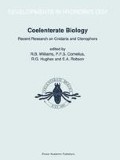Abstract
The ability of the hermit crabs Dardanus venosus and Pagurus pollicaris to recognize chemically their symbiotic sea anemone Calliactis tricolor and a common octopus predator, Octopus joubini, were studied. The crabs were tested for chemoreceptive responses using a Y-trough olfactometer, which prevented visual cues from being used. Choice tests showed that D. venosus could chemically detect Calliactis. If, however, D. venosus had a Calliactis on its shell at the time of the trial, it could not detect the test anemone. P. pollicaris (without a symbiotic anemone) did not locate the test anemone. Both species of crab avoided a water current carrying octopus chemical cues. Chemoreception may play an important role in the interaction of a hermit crab with its symbiotic anemone and an octopus predator.
Access this chapter
Tax calculation will be finalised at checkout
Purchases are for personal use only
Preview
Unable to display preview. Download preview PDF.
References
Ache, B. W., 1974. The experimental analysis of host location in symbiotic marine invertebrates. In W. B. Vernberg (ed.), Symbiosis in the Sea. Univ. of South Carolina Press,Columbia: 45–60.
Balasch, J. & V. Mengual, 1974. The behavior of Dardanus arrosor in the association with Calliactis parasitica in artificial habitat. Mar. Behav. Physiol. 2: 251–260.
Brooks, W. R., 1988. The influence of the location and abundance of the sea anemone Calliactis tricolor (Lesueur) in protecting hermit crabs from octopus predators. J. exp.mar. Biol. Ecol. 116: 15–21.
Brooks, W. R. & R. N. Mariscal, 1985a. Protection of the hermit crab Pagurus pollicaris Say from predators by hydroid-colonized shells. J. exp. mar. Biol. Ecol. 87: 111–118.
Brooks, W. R. & R. N. Mariscal, 1985b. Asexual reproduction by the symbiotic sea anemone Calliactis tricolor (Lesueur). Bull. mar. Sci. 36: 432–435.
Brooks, W. R. & R. N. Mariscal, 1986. Population variation and behavioral changes in two pagurids in association with the sea anemone Calliactis tricolor (Lesueur). J. exp. mar. Biol. Ecol. 103: 275–289.
Davenport, D., 1966. The experimental analysis of behavior in symbioses. In S. M. Henry (ed.), Symbiosis, 1. Academic Press, N.Y.: 381–429.
Grant, W. C. & P. J. Pontier, 1973. Fitness in the hermit crab Pagurus acadianus with reference to Hydractinia echinata. Bull. Mt Desert Isl. biol. Lab. 13: 50–53.
McLean,R., 1983. Gastropod shells: a dynamic resource that helps shape benthic community structure. J. exp. mar. Biol. Ecol. 69: 151–174.
McLean, R. B. & R. N. Mariscal, 1973. Protection of a hermit crab by its symbiotic sea anemone Calliactis tricolor. Experientia 29: 128–130.
Ross, D. M., 1971. Protection of hermit crabs (Dardanus spp.) from octopus by commensal sea anemones [Calliactis spp.). Nature, Lond. 230: 401–402.
Ross, D. M., 1974. Evolutionary aspects of associations between crabs and sea anemones. In W. B. Vernberg (ed.), Symbiosis in the Sea. Univ. of South Carolina Press, Columbia: 111–125.
Ross, D. M., 1979. ’Stealing’ of the symbiotic anemone, Calliactis parasitica, in intraspecific and interspecific encounters of three species of Mediterranean pagurids. Can. J. Zool. 57: 1181–1189.
Ross, D. M., 1980. Post-metamorphic life history of the symbiotic anemone Calliactis parasitica (Couch.). In P. Tardent & R. Tardent (eds), Developmental and Cellular Biology of Coelenterates. Elsevier/North-Holland Biomedical Press, Amsterdam: 171–174.
Ross, D. M. & S. Boletzky, 1979. The association between the pagurid Dardanus arrosor and the actinian Calliactis parasitica. Recovery of activity in ‘inactive’ D. arrosor in the presence of cephalopods. Mar. Behav. Physiol. 6: 175–184.
Snyder, N. F. R. & H. A. Snyder, 1971. Pheromone-medi-ated behavior of Fasciolaria tulipa. Anim. Behav. 19: 257–268.
Author information
Authors and Affiliations
Editor information
Rights and permissions
Copyright information
© 1991 Springer Science+Business Media Dordrecht
About this paper
Cite this paper
Brooks, W.R. (1991). Chemical recognition by hermit crabs of their symbiotic sea anemones and a predatory octopus. In: Williams, R.B., Cornelius, P.F.S., Hughes, R.G., Robson, E.A. (eds) Coelenterate Biology: Recent Research on Cnidaria and Ctenophora. Developments in Hydrobiology, vol 66. Springer, Dordrecht. https://doi.org/10.1007/978-94-011-3240-4_42
Download citation
DOI: https://doi.org/10.1007/978-94-011-3240-4_42
Publisher Name: Springer, Dordrecht
Print ISBN: 978-94-010-5428-7
Online ISBN: 978-94-011-3240-4
eBook Packages: Springer Book Archive

